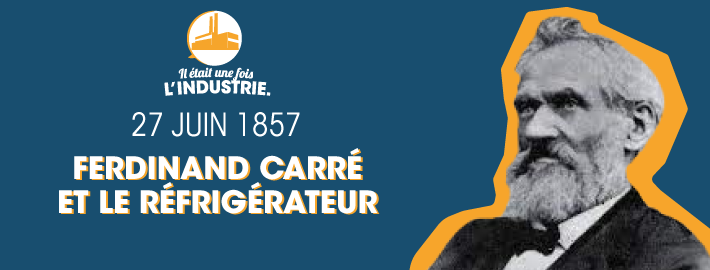GLOBAL
INDUSTRIE
News
Share on

27 June 1857: Ferdinand Carré and the refrigerator
What happened this week in the History of Industry? It is to answer this question that we invite you to rediscover, every week, a historical event which occurred around this time… in another age. Keen to bring you a bit of coolness in this beautiful month of June, we tell you today about the creation of one the earliest refrigerators, the patent for which was filed by a Frenchman exactly 164 years ago.
PICARDY FREEZE-OUT
Ferdinand Carré was a die-hard Picard. Born in Moislains in the Somme on the 11th of March 1824, he had a younger brother Edmond who, like him, was to become an engineer. Although born nine years later, Edmond was the first to distinguish himself in the field for which the two brothers were to become famous by developing in 1850, at the age of barely 17, a refrigeration process based on water and sulfuric acid. A project which was taken up by his older brother and which was to give rise to the absorption refrigerator for which he filed a patent on the 27th of June 1857, under the nose of a certain Charles Tellier, with whom he remained on frosty terms throughout his life.
This is, in practice, a system based on two liquids: water, used as an absorbent, and ammonia, used as a coolant. A heat source drives the cycle enabling the heat inside the device to be extracted, instead of the compressor habitually used. This is particularly useful, even today, when access to electricity is limited – as in the case of a camper van – or when an inexpensive heat source is available: sunshine, gas, etc.
Whether the refrigerator is of the compression or absorption type, its functioning is based on the evaporation of a low-temperature liquid which allows the heat inside the device to be absorbed by playing on the high and low pressure phenomena. In the case of the device invented by Ferdinand Carré, the absorption phenomenon creates the low pressure while the high pressure is obtained by heating. All of this using two separate fluids, a coolant, in this case ammonia, and an absorber which serves as a compressor, water.
AN INVENTION WHICH CASTS A CHILL
And when we think of Picardy we think of… beer! Carré’s invention was thus first successfully deployed in breweries, particularly the Tourtel brewery in Tantonville in Meurthe-et-Moselle, the first in which it was installed. It was capable of producing between 12 and 100 kilos of ice depending on the model. He then exported his patent to the United States and became famous by exhibiting his machine manufacturing enormous quantities of ice continuously at the London Universal Exhibition in 1862.
It would be wrong, however, to think that our ancestors’ homes were rapidly won over by his system, which they continued to give the cold shoulder for many years. In fact, this system was for a long time to remain the preserve of industry, ammonia being risky to handle. This did not prevent Ferdinand Carré from quickly offering our forefathers a system consisting of a small charcoal-fired stove cooled by ammonia gas. This device, considered to be too complex, was given a very cool reception.
Decorated, like his younger brother, with the Legion of Honor, Ferdinand Carré died at the age of 75 on the 11th of January 1900, not before giving his name to the "Carré cycle", which describes the absorption refrigeration process with two fluids and two pressure levels, and after making a significant contribution to research into electricity, notably via the development of a light regulator.
2021.06.21